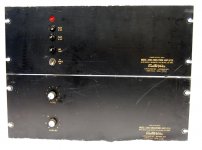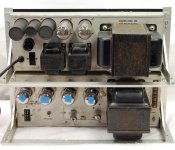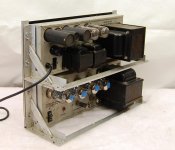It depends on how good you are at designing a solution for what happens in the cross-over region from one output tube to the other..
McIntosh made some pretty good sounding, but fairly complex class B/near class B amplifiers with very clever transformer design (unity coupled) to minimize the effect of cross-over distortion in their output stage.
Why anyone would necessarily want to/need to copy this approach today is a question I can't answer..
Need really high power go solid state..
McIntosh made some pretty good sounding, but fairly complex class B/near class B amplifiers with very clever transformer design (unity coupled) to minimize the effect of cross-over distortion in their output stage.
Why anyone would necessarily want to/need to copy this approach today is a question I can't answer..
Need really high power go solid state..
Screen drive of high perveance tubes also seems to work very well at a cost of very high drive requirements. My last big amp ran near-Class-B and sounded fine. Tubelab has been making similar efforts recently and his are well worth exploring.
You might want to study the David Berning EA230 and EA2100/2101 designs.
You might want to study the David Berning EA230 and EA2100/2101 designs.
Class B mean long live for output tubes too and high overall Amp eficiency. ,Mcintosh solved crossover class B switching with `Unity coupling`design of output stage&OPT but Electro Voice solved that with Circlotron output stage design very efectiv too.BTW ElectroVoice/Voima /Circlotron OPT(or autotransformer)is very simple to made.Good Luck to Everybody
Screen drive of high perveance tubes also seems to work very well at a cost of very high drive requirements. My last big amp ran near-Class-B and sounded fine. Tubelab has been making similar efforts recently and his are well worth exploring.
You might want to study the David Berning EA230 and EA2100/2101 designs.
Out of interest, how well does screen drive work with the usual suspects? (EL34, KT88 etc)
Class B mean long live for output tubes too and high overall Amp eficiency. ,Mcintosh solved crossover class B switching with `Unity coupling`design of output stage&OPT but Electro Voice solved that with Circlotron output stage design very efectiv too.BTW ElectroVoice/Voima /Circlotron OPT(or autotransformer)is very simple to made.Good Luck to Everybody
Circlotrons are typically class A to some level of output and then AB the rest of the way to full output to the best of my recollection - there has to be some minimum current flowing in the loop at all times for reasonable linearity.
Circlotrons are typically class A to some level of output and then AB the rest of the way to full output to the best of my recollection - there has to be some minimum current flowing in the loop at all times for reasonable linearity.
Hi Kevin Kr. Class A/AB for some OTL Circlotron design is 100% truth but ElectroVoice Circlotron with OPT design is AB biased but much closer to B class biased(A100 model for example).You can found that EV Amp schematic on Net site -Circlotron History page-.One of advantages of Circlotron (OPT or autoformer) Amp design biased near to Class B is no switching transient and wide frequency range,this second is due wery simple OPT or autoformer,and long output tube live/high overall Amp eficiency(mentionet before)
. . .
but Electro Voice solved that with Circlotron output stage design very efectiv too.BTW ElectroVoice/Voima /Circlotron OPT(or autotransformer)is very simple to made.Good Luck to Everybody
Yes, but keep in mind that the two power supplies MUST float at ALL frequencies, not simply DC insulated.
This usually asks for a specially wound power transformator with very high leakage inductance between the two HV windings . . . no free beer !
Also consider Norman Crowhurst's approach with two independent OPT coupled by their secondary (for lo frequency) and the two caps "cross coupling" each anode to the opposite cathode for hi end.
http://www.dissident-audio.com/AutoIndex/index.php?dir=Yves/&file=1960crowhurst.pdf
Yves.
No special power transformer for Circlotron output stage is necesary(SS or Tube Circlotron),(OTL or OPT or Autotrafo Circlotron Amplifier). Example-With ordinary power trafo (EI or toroid) with two independent secondary,rectified with two independent bridge(Greatz)and smoothed with two independent filter and coupled to OTL Circlotron power stage bandwith goes easy from 0 hz to Mhz range.Lower frequencies depend from filter value only and power trafo curent capability,and upper freq. not so much from Output Circlotron stage(or floathing PSU) but from driver/input stage configuration(please see the post-What tubes for tube Amp).With OPT or Autotrafo coupled Circlotron output stage lowest/highest freq.(bandwidth)depends only from OPT quality,autotrafo allow even more wide bandwidth than OPT. What is important for Circlotron Psu is next:Both power transf.secondary have to be conected in same manner to Greatz rectifier(in Phase).This Mr Norman Crowhurst presented circuit is Not Circlotron at all.The best thing in Tube Amp Circlotron topology is no switching transient allmost near to B klass regime.Best RegardYes, but keep in mind that the two power supplies MUST float at ALL frequencies, not simply DC insulated.
This usually asks for a specially wound power transformator with very high leakage inductance between the two HV windings . . . no free beer !
Also consider Norman Crowhurst's approach with two independent OPT coupled by their secondary (for lo frequency) and the two caps "cross coupling" each anode to the opposite cathode for hi end.
http://www.dissident-audio.com/AutoIndex/index.php?dir=Yves/&file=1960crowhurst.pdf
Yves.
Mmmmh . . . .
I agree more or less !
Speaking about OTL circlotrons means low Z and yes, in this context, parasitic caps of few nanofarads between HV sources do not matter.
I showed the Crowhurst paper as a way to void using a bifilar OPT in a "McIntosh like" configuration wich try to acheive the same "unity coupled" scheme that the -obviously much most clever- circlotron.
Yves.
I agree more or less !
Speaking about OTL circlotrons means low Z and yes, in this context, parasitic caps of few nanofarads between HV sources do not matter.
I showed the Crowhurst paper as a way to void using a bifilar OPT in a "McIntosh like" configuration wich try to acheive the same "unity coupled" scheme that the -obviously much most clever- circlotron.
Yves.
Mcintosh` unity coupling` OPT is very complex and expencive part.ElectroVoice Circlotron OPT is not, even for homemade production.Basicly beacose Rkk impedance of Circlotron Amp is only fourth part of Raa impedance for `clasic` push-pull Amp OPT( with same output power tubes and same bias class).Second- Vkk` peak voltage is drasticly lower than Vaa`peak voltage,so OPT isolation issue is not critical.Third-center of primary windings Circlotron OPT is grounded(only for ground reference for driver stage).Fourth-NO DC curent in OPT primary.Fifth-Circlotron OPT Amplifier can run without Load(speaker) allmost at full power with no capital damage, clasic PP OPT Amp will blow.Six-Sound Perfect(special Multiphase OTL Circlotron).Plase see the greath NET cite :Circlotron History Page-Many Cyrclotron related stuff,schematic&theory.Best Regard
...Fourth-NO DC curent in OPT primary.
...only if the drive is symetric and tubes are reasonably similar. This is normally fairly easy to insure, however, it does not come automatically.
A curclotron also has comparatively low output impedance, so very little or even no global feedback is necessary even for really badly behaved speakers.
Circlotrons in general have two drawbacks: 1) multitude of power supplies, and 2) very high swings necessary out of the driver stage. IMHO, both are far from undiscovered country which makes it a very worthwhile topology to explore.
`Wish You were here` but 2x:ElectroVoice A100e.Must corect myself:OPT primary center is conected to ground not only for driver stage ground reference but for output tube bias ground reference too.
Attachments
Last edited:
Today in USA there is no manufacture who produce Pentode OPT Circlotron Amps AB/B biased. only BAT(Balanced Audio Technology)but that Amps are Triode classA/AB.Here in Europa is single one:Experience Electronics-Germany.Cool OPT EXPERIENCE electronics - HauptauswahlCirclotron pentode Amps(finished or Kit complete 40w-240w)differ from EV Circlotron Amps topology,very good OPT and many other cool stuff.Here is basic Schematic for Expirience Electronics Amps( Circlotron, OPT, 6xel34,140W,classAB,self biased(automatic),UBA 450V(2x)OPT primary only 330 ohm(Rkk)
Attachments
Silly question.
Reason: with enough NFB (assuming sufficient bandwidth to apply it), any amp will sound exactly like an SS amp, i.e., have no sound whatsoever. For the same reason.
Tim
Silly answer.
Reason: in order to get the same sound as SS tube amp with no FB should exhibit the same non-linearities like SS amp does, and the same in-band phase shift. "No sound whatsoever" is the target in high-end, no matter what was used: tubes, or transistors, or their combination. If the amp is already linear and wideband with no NFB applied, it will never sound artificially.
Silly answer.
Reason: in order to get the same sound as SS tube amp with no FB should exhibit the same non-linearities like SS amp does, and the same in-band phase shift. "No sound whatsoever" is the target in high-end, no matter what was used: tubes, or transistors, or their combination. If the amp is already linear and wideband with no NFB applied, it will never sound artificially.
Agree with You Bachuska
Agree with You Bachuska
Go in Peace, Otrok!

However, everything can be damaged. For example, a dominant pole compensation added causing in-band phase shift when inormously deep feedback applied to more than 2 stages. The result will be horrible clipping, no matter what kind of active components were used: the stage preceding the slowest one may cough on transients. But it is not about feedback, and not about tubes VS transistors, it is about reckless design.
- Status
- This old topic is closed. If you want to reopen this topic, contact a moderator using the "Report Post" button.
- Home
- Amplifiers
- Tubes / Valves
- Class B Push-Pull


